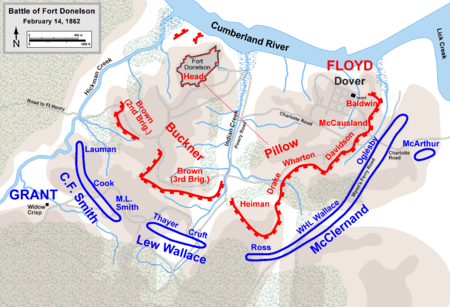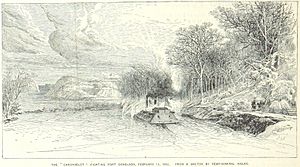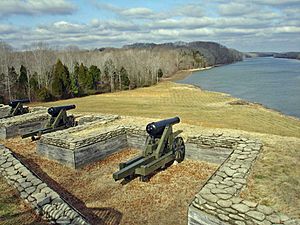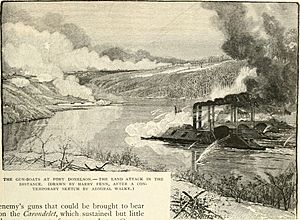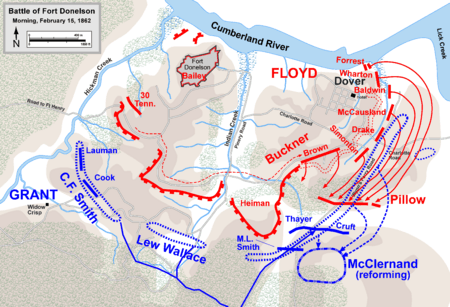Battle of Fort Donelson facts for kids
Quick facts for kids Battle of Fort Donelson |
|||||||
|---|---|---|---|---|---|---|---|
| Part of the American Civil War | |||||||
|
|||||||
| Belligerents | |||||||
| Commanders and leaders | |||||||
| Units involved | |||||||
|
|
||||||
| Strength | |||||||
| 24,531 | 16,171 | ||||||
| Casualties and losses | |||||||
| 2,691 total (507 killed 1,976 wounded 208 captured/missing) |
13,846 total (327 killed 1,127 wounded 12,392 captured/missing) |
||||||
The Battle of Fort Donelson was a major fight during the American Civil War. It happened from February 11 to 16, 1862. This battle took place in the Western part of the war. The Union forces captured a Confederate fort near the border of Tennessee and Kentucky. This victory was very important. It opened up the Cumberland River for Union ships. This river was a key path for the Union to move into the South.
The success at Fort Donelson also made Ulysses S. Grant famous. He was a Brigadier General at the time. After this battle, he became a Major General. He also earned the famous nickname "Unconditional Surrender" Grant. This was because of his tough demands for the Confederates to give up.
Before this battle, Grant had captured Fort Henry on February 6. He then marched his army about 12 miles (19 km) to Fort Donelson. This march took place from February 11 to 13. On February 14, Union gunboats tried to attack the fort from the river. But the fort's cannons fired back hard. The Union boats had to pull back because they were badly damaged.
On February 15, the Confederate soldiers launched a surprise attack. They were led by John B. Floyd and Gideon Johnson Pillow. Their goal was to create an escape route to Nashville, Tennessee. Grant was not there when the attack started. But he arrived later to rally his troops. Pillow's attack did open an escape path. However, General Floyd lost his courage. He ordered his men back inside the fort. The next morning, Floyd and Pillow escaped with a few soldiers. They left Simon Bolivar Buckner in charge. Buckner then accepted Grant's demand for "unconditional surrender." This Union victory meant that most of Kentucky and much of Tennessee, including Nashville, came under Union control.
Contents
Why the Battle Happened
Military Situation in 1862
The Battle of Fort Donelson happened soon after Fort Henry surrendered on February 6, 1862. Fort Henry was a key fort defending Tennessee. Its capture opened the Tennessee River for Union troops and supplies. About 2,500 Confederate soldiers escaped from Fort Henry. They marched 12 miles (19 km) east to Fort Donelson. After Fort Henry fell, Union troops cut the railroad lines south of the fort. This made it harder for Confederates to send more soldiers to defend Fort Donelson.
The Confederates faced tough choices after Fort Henry. Grant's army now split the main Confederate forces. Albert Sidney Johnston was the Confederate General. He had two main armies. One was led by P. G. T. Beauregard at Columbus, Kentucky. The other was led by William J. Hardee at Bowling Green, Kentucky. Fort Donelson had only about 5,000 men.
Johnston was worried about the Union gunboats. He thought they easily defeated Fort Henry. He decided to send more soldiers to Fort Donelson. He knew that losing Fort Donelson would mean losing Middle Tennessee. Nashville, an important city for making supplies, would also be lost. Johnston wanted P. G. T. Beauregard to command Fort Donelson. But Beauregard was sick. So, John B. Floyd took command. Floyd was a politician, not a military expert. But he was the highest-ranking general there.
On the Union side, Henry W. Halleck was Grant's boss. He was worried about Grant's plan to attack Fort Donelson. Halleck thought Grant was too reckless. But Grant was determined. He knew any delay could make Halleck cancel the attack.
Grant had planned to take Fort Donelson by February 8. But bad roads and damaged gunboats caused delays. On February 11, Grant held a meeting with his generals. They all agreed to attack Fort Donelson. This was the last time Grant held such a meeting during the entire Civil War.
Who Fought in the Battle
Union Forces and Leaders
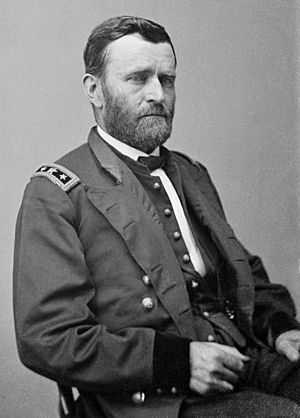
Grant's Union army was called the Army of the Tennessee. It had three main groups of soldiers, called divisions. These were led by Brigadier General McClernand, Brigadier General C.F. Smith, and Brigadier General Lew Wallace. At first, Wallace was in reserve. But he was called to bring more soldiers. The Union forces had about 25,000 men in total. About 15,000 were ready at the start of the battle.
The Union also had a group of gunboats. This was the Western Gunboat Flotilla. It was led by Flag Officer Andrew H. Foote. It had four strong ironclad gunboats. These were the USS St. Louis, USS Carondelet, USS Louisville, and USS Pittsburg. There were also three wooden gunboats.
Confederate Forces and Leaders

The Confederate force had about 17,000 men. They were led by John B. Floyd. His force included three divisions. These were led by Floyd himself (later by Colonel Gabriel C. Wharton), Bushrod Johnson, and Simon Bolivar Buckner. Brigadier General Gideon J. Pillow also played a big role. He arrived on February 9. Colonel Nathan Bedford Forrest led the cavalry.
Fort Donelson was named after Daniel S. Donelson. He chose the spot and started building it in 1861. It was much stronger than Fort Henry. Fort Donelson was on a hill about 100 feet (30 m) above the Cumberland River. This height allowed its cannons to fire down on enemy boats. This was a big advantage. The fort had twelve cannons facing the river.
Around the fort, there were three miles (5 km) of trenches. These trenches formed a semicircle around the fort and the town of Dover. The trenches were on a ridge. In front of them were cut trees and branches. These pointed outwards to stop attackers. Buckner's men defended the right side. Johnson and Pillow's men defended the left side.
The Battle Begins
First Moves and Small Attacks (February 12–13)
On February 12, most Union troops left Fort Henry. They marched about 5 miles (8 km) towards Fort Donelson. Confederate cavalry, led by Nathan Bedford Forrest, tried to slow them down. After a small fight, Forrest's men pulled back into their trenches. The Union troops then moved closer to the Confederate defenses. They tried to block any escape routes. McClernand's division was on the right of Grant's army. C.F. Smith's division was on the left. The USS Carondelet gunboat arrived first on the river. It fired shells into the fort to test its defenses.
On February 11, General Floyd had ordered some troops to move south. This was to attack Union supply lines. But it would leave Fort Donelson with too few defenders. Pillow left on February 12 to discuss this with Floyd. When he heard fighting, Pillow returned to the fort. Buckner stayed to command the Confederate right side.
On February 13, Union soldiers made small attacks. They were not supposed to start a big fight. But they tested the Confederate defenses. On the Union left, C.F. Smith sent two brigades to attack. They had light losses and didn't gain ground. But they kept firing all night. On the right, McClernand also ordered an attack. Two regiments tried to capture a Confederate cannon battery. This attack failed. Some wounded soldiers got caught between the lines. They died in grass fires started by artillery.
General Grant had the Carondelet fire on the fort. This was to distract the Confederates. The Confederates fired back and hit the gunboat. McClernand's men tried to reach the river. But they faced strong Confederate cannons. Grant realized he needed more soldiers. He called General Wallace to bring his men from Fort Henry.
Floyd arrived and took overall command of Fort Donelson. Pillow then led the Confederate left. Floyd felt overwhelmed. He let Pillow and Buckner handle most of the fighting. By the end of the day, there were many small fights. But neither side had gained much ground. The night was very cold. A snowstorm arrived on February 13. Temperatures dropped to 10–12 °F (−12 °C). About 3 inches (8 cm) of snow fell. Soldiers could not light fires. Many had no blankets or warm coats. Both sides suffered greatly from the cold.
More Soldiers and a River Battle (February 14)
Early on February 14, Floyd held a meeting. The generals agreed that Fort Donelson might not be able to hold out. They planned to break out and escape to Nashville. Troops were moved to get ready. But at the last minute, a Union sharpshooter killed one of Pillow's helpers. Pillow got scared. He said the escape had to be put off. Floyd was very angry. But it was too late to change plans.
Around noon on February 14, General Lew Wallace's soldiers arrived. Foote's gunboats also arrived on the Cumberland River. They brought 10,000 more Union soldiers on twelve ships. Wallace formed these new troops into a third division. They took the middle of the Union line. This gave the Union enough soldiers to extend McClernand's right side. It now reached Lick Creek.
As soon as Foote arrived, Grant told him to attack the fort's river cannons. Foote was careful. But he moved his gunboats close to the shore by 3:00 p.m. He opened fire, just like at Fort Henry. Confederate gunners waited until the boats were very close. Then they fired back. The Confederate cannons hit the Union fleet hard. The attack was over by 4:30 p.m. Foote was wounded in his foot. His main ship, USS St. Louis, was badly damaged. It floated away helplessly. Other Union ships were also damaged.
The Union fleet was badly hurt. It retreated downriver. The St. Louis was hit 59 times. The Carondelet was hit 54 times. Eight Union sailors died, and 44 were wounded. The Confederates had no losses from this attack. Grant realized that the army would have to win the battle without much help from the navy. He told Halleck that he might have to surround the fort.
Confederate Breakout Attempt (February 15)
Even though their river defense was successful, the Confederate generals were still worried. They held another meeting late at night. They decided to try their escape plan again. At dawn on February 15, the Confederates attacked. Pillow led the attack against McClernand's division. This was on the unprotected right side of the Union line. The Union soldiers were not completely surprised. But Grant was. He didn't expect a land attack. He had gone to visit Flag Officer Foote on his ship. Grant left orders that no general should start a fight. No one was left in charge while he was gone.
The Confederate plan was for Pillow to push McClernand's men back. This would open the roads to Nashville. Buckner was to move his division across Wynn's Ferry Road. He would protect the army as it left Fort Donelson. The attack started well. After two hours of hard fighting, Pillow's men pushed McClernand's line back. This opened the escape route. During this attack, Union soldiers heard the famous "rebel yell" for the first time in the West.
The attack worked at first because McClernand's troops were new and in bad positions. Also, Confederate cavalry under Forrest attacked their side. Union brigades were hit hard. They pulled back in an orderly way to regroup. McClernand ran out of ammunition. He asked Lew Wallace for help. But Wallace had no orders from Grant. He didn't want to disobey orders. Wallace sent a helper to Grant's headquarters. Meanwhile, McClernand's men were still retreating. Another messenger arrived at Wallace's camp, crying. He said, "Our right flank is turned! The whole army is in danger!" This time, Wallace sent a brigade to help McClernand.
Not everything went well for the Confederates. By 9:30 a.m., Forrest urged Bushrod Johnson to attack the disorganized Union troops. But Johnson was too careful. He only agreed to move slowly forward. Two hours into the battle, Pillow realized Buckner's men were not attacking with his. After an argument, Buckner's troops moved out. They attacked a Union brigade. The Confederates took control of key roads. This opened a path to Nashville. But Buckner's delay gave Lew Wallace's men time to help McClernand's retreating forces. Wallace's units moved to the right. This gave McClernand's men time to regroup and get more ammunition.
The Confederate attack ended around 12:30 p.m. Wallace's and Thayer's Union troops formed a new defense line. The Confederates attacked them three times but failed. They pulled back. Still, they had done well that morning. They had pushed the Union defenders back one to two miles (2–3 km). They had opened their escape route.
Grant, who didn't know about the battle, returned in the early afternoon. He was upset by the confusion. He told McClernand, "It seems so. Gentlemen, the position on the right must be retaken." Grant did not panic. He saw that some Confederates had knapsacks filled with food. This meant they were trying to escape, not win the battle. He told an aide, "The one who attacks first now will be victorious."
Despite their successful morning attack, Pillow ordered his men back to their trenches by 1:30 p.m. Buckner argued with Pillow. Floyd wanted to change the order. But Pillow said his men needed to regroup. Pillow won the argument. Floyd also thought Smith's division was getting many more soldiers. So, the entire Confederate force was ordered back inside Fort Donelson. They gave up the ground they had gained.
Grant quickly took advantage of this. He told Smith, "All has failed on our right—you must take Fort Donelson." Smith replied, "I will do it." Smith attacked the Confederate right side. His attack quickly captured the outer trenches. The Confederates tried to fight back for two hours. But they could not push Smith out. The Union was now ready to capture Fort Donelson the next morning.
Meanwhile, on the Union right, Lew Wallace formed an attack. He used three brigades. They tried to get back the ground lost that morning. Wallace's troops succeeded. By nightfall, the Confederate troops were back in their original positions. Grant planned to continue his attack in the morning.
The Surrender (February 16)
Almost 1,000 soldiers on both sides had died. About 3,000 were wounded and still on the field. Some froze to death in the snowstorm. Many Union soldiers had thrown away their blankets and coats.
Generals Floyd and Pillow were surprisingly happy about the day's fighting. They sent messages to General Johnston saying they had won a great victory. But General Simon Bolivar Buckner disagreed. He said they were in a terrible situation. It was getting worse as more Union soldiers arrived. At their last meeting at 1:30 a.m. on February 16, Buckner said he could only hold out for thirty minutes if Smith attacked again. He thought 75% of their men would be killed or wounded.
Floyd believed he would be arrested if captured. He had been Secretary of War before the war. He quickly gave his command to Pillow. Pillow also feared being captured. Pillow then gave command to Buckner. Buckner agreed to stay and surrender the army. During the night, Pillow escaped by boat. Floyd left the next morning on the only available ship. He took his two regiments of soldiers. Nathan Bedford Forrest was disgusted. He said, "I did not come here to surrender my command." He left the meeting. He led about seven hundred of his cavalrymen to escape the fort. Forrest's men rode through the shallow, icy waters of Lick Creek. They met no enemy. This showed that many more could have escaped.
On the morning of February 16, Buckner sent a note to Grant. He asked for a truce and surrender terms. The note first reached General Smith. Smith said, "No terms to the damned Rebels!" When Grant got the note, Smith urged him to offer no terms. Buckner had hoped Grant would be kind. They had been friends earlier. But Grant showed no mercy. Grant's short reply became famous. It earned him the nickname "Unconditional Surrender":
Sir: Yours of this date proposing Armistice, and appointment of Commissioners, to settle terms of Capitulation is just received. No terms except unconditional and immediate surrender can be accepted.
I propose to move immediately upon your works.
- I am Sir: very respectfully
- Your [obedient servant]
- U.S. Grant
- Brig. Gen.
Grant was not bluffing. Smith was in a good position to attack the fort. He had captured the outer defenses. Grant believed he could storm the fort successfully. Buckner replied to Grant's demand:
SIR:—The distribution of the forces under my command, incident to an unexpected change of commanders, and the overwhelming force under your command, compel me, notwithstanding the brilliant success of the Confederate arms yesterday, to accept the ungenerous and un chivalrous terms which you propose.
Grant was polite to Buckner after the surrender. He offered to lend him money. But Buckner refused. The surrender was a big defeat for the Confederacy. They lost over 12,000 men. They also lost 48 cannons and much equipment. They lost control of the Cumberland River. This led to the Union taking Nashville. This was the first of three Confederate armies Grant would capture. Over 7,000 Confederate prisoners were sent to prison camps in the North.
What Happened After the Battle
The Battle of Fort Donelson had many casualties. Union losses were 2,691 soldiers. This included 507 killed and 1,976 wounded. Confederate losses were 13,846 soldiers. This included 327 killed, 1,127 wounded, and 12,392 captured or missing. The large number of captured Confederates made the total losses very high.
News of the victory made people in the North very happy. Cannons were fired and church bells rang. The capture of Forts Henry and Donelson were the first big Union victories. They opened two major rivers for the Union to invade the South. Grant was promoted to major general. He was now second in command only to Henry W. Halleck in the West. Newspapers said Grant won the battle with a cigar in his mouth. After that, he received many cigars from fans. He became a heavy smoker, which may have led to his later death from throat cancer.
Almost a third of General Albert Sidney Johnston's forces were now prisoners. Grant had captured more soldiers than all previous American generals combined. Johnston lost over twelve thousand soldiers. These soldiers could have helped him in the upcoming Battle of Shiloh. Johnston's remaining forces were far apart. Grant's army was between them. Grant's forces also controlled nearby rivers and railroads. General Buell's army threatened Nashville. Johnston left Nashville on February 23. Nashville was an important city for making supplies. It became the first Confederate state capital to fall. Most of Tennessee came under Union control. All of Kentucky also came under Union control.
Protecting the Battlefield
The place where the battle happened is now a protected site. It is called Fort Donelson National Battlefield. The National Park Service takes care of it. The American Battlefield Trust and its partners have also helped. They have bought and saved 369 acres (1.49 km2) of the battlefield. Most of this land has been given to the park service.
Images for kids


